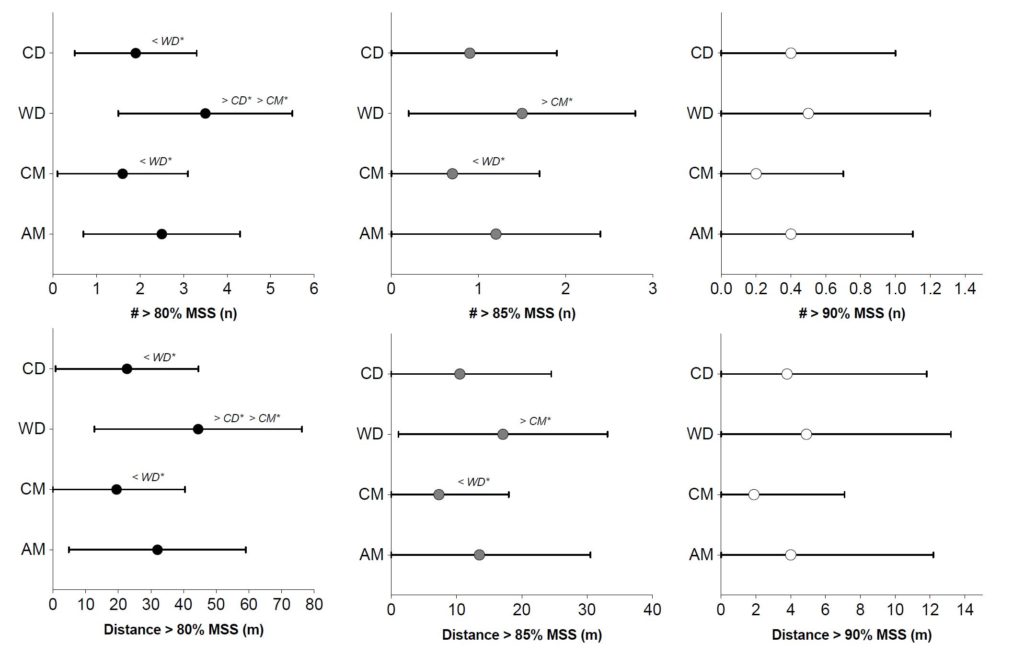Occurrences of near-to-maximal speed running bouts in elite soccer: insights for training prescription and injury mitigation
Buchheit, M., Simpson, BM, Hader, K., and Lacome, M. Occurrences of near-to-maximal speed running bouts in elite soccer: insights for training prescription and injury mitigation. Science & Medicine in Football, In press.
Full text here
Abstract
The aim of the present study was to quantify the occurrence of near-to-maximal speed running bouts in elite soccer players. Tracking match data from 35 elite professional players (23±3 yrs) were analysed over four seasons (2015-2019). The number of runs reaching >80, >85 and >90% of players’ individual maximal sprinting speed (MSS) were computed. Potential differences in peak speed occurrences between halves and positions were analysed. The occurrences was not different between halves (trivial effect sizes), but slightly- to-moderately position-dependent, with wingers (3.5±2.0 runs >80%, 1.5±1.3 >85% and 0.5±0.7 >90% per half) and central midfielders (1.6±1.5 runs >80%, 0.7±1.0 >85% and 0.2±0.5 >90% per half) performing the most and the least number of near-to-maximal speed running bouts. Players did not reach >90% of MSS at all in 35% (Attackers) to 65% (Midfielders) of their matches; they reached ≥3 times >90% MSS per match in 2% (Midfielders) to 11% (Attackers) of their matches only. The maximal number of cumulated match occurrences during congested periods were observed in a central defender (̴2 runs >90% of MSS every 4 days for 31 days, starting 8/8 matches) and a winger (1 run every 4 days for 52 days starting 13/14 matches). The occurrence of near-to-maximal speed running bouts is low in elite soccer. Match context, playing position and individual player profile are the main determinants of those occurrences. The present data can nevertheless help practitioners to design compensation sessions for substitutes, which should be useful in the context of both performance enhancement and injury mitigation.
Keywords: player monitoring; peak speed; sprinting; compensation; injury.
Practical applications.
- The present data can be used to organise (positional) compensatory work for bench and substitute players, especially when it comes to maintaining a stable sprinting load across the weekly macrocycle.
- We suggest accumulating a weekly workload of 2-3 match loads to avoid any spike in loads for substitute players having to suddenly play twice a week. This chronic workload can be achieved via match exposures only (starters, Figure 2), match and compensation session (substitutes) or compensation sessions only (bench players).
- A typical full match top speed compensation session for a WD for example may be composed of 6-8 runs >80% MSS, with 3 of them >85% and 1-2 >90% MSS.
- Further than compensating for the number of near-to-maximal (linear) sprints, practitioners may also need to integrate specific sprint functions and patterns in relation to possible match contexts35, i.e., attacking vs. defensive sprints including curved sprints and torso rotation; this may increase specificity both in terms of performance and injury mitigation.

Figure 1. Number of occurrences of >80%, >85% and >90% MSS running bouts (upper panels), and cumulated distance run above those speed thresholds (lower panels) for the main four positions. Only first halves were used to increase sample size. CD: central defenders (n = 378), WD: wide defenders (n = 152), CM: central (n = 300) midfielders, AT: Attackers (n = 349). *: likely between-position differences. The direction of the differences is shown by the ‘>’ and ‘<’ signs. For example, ‘<WD*’ shown on the side of the CD value (upper left panel) means that CD presented likely lower occurrences than WD.

Figure 2. Examples of time blocks including three repeated congested periods (playing with ≤4 days between matches) showing the occurrence of >80%, >85% and >90% MSS running bouts in two representative players.



